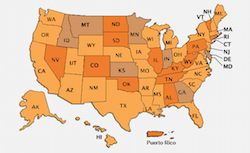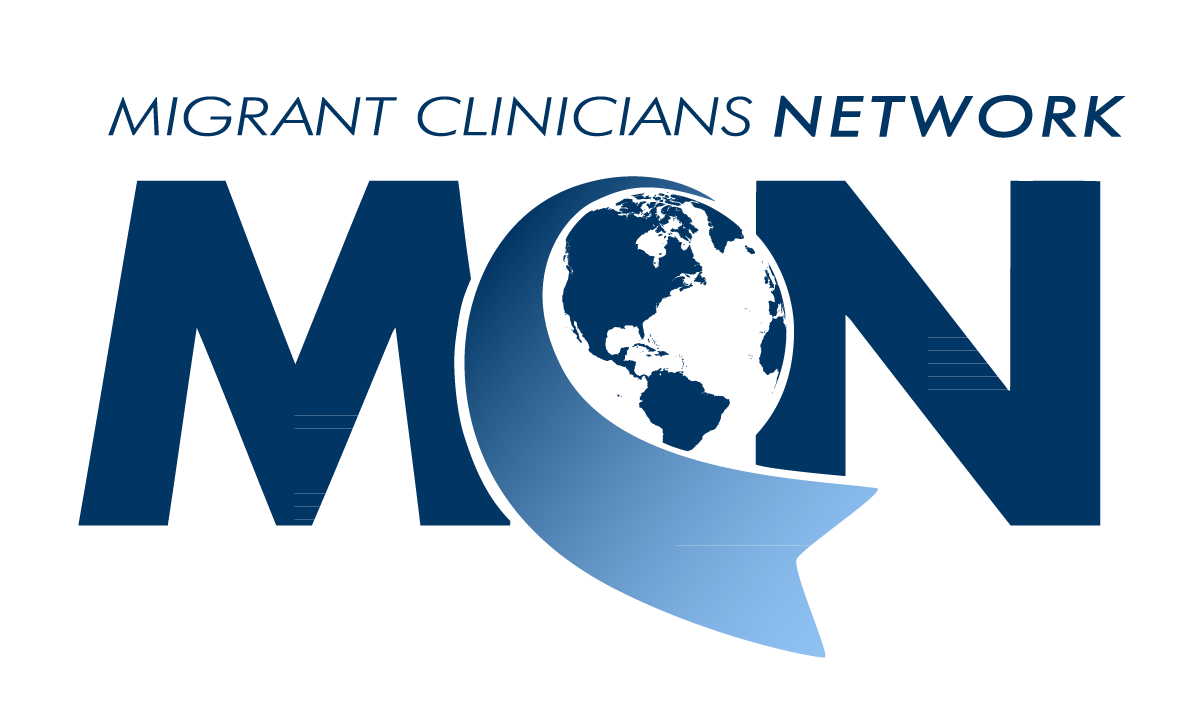- Who We Are
- Clinician Employment
- Publications
- Witness to Witness (W2W)
- El Premio Kugel & Zuroweste a la Justicia en la Salud
- Your Voice Matters: Photovoice Project
Announcements
Close Announcements⇧
Spotlight
Promising Practices
Health Center
Their Story
The Community Clinic of Maui has a fully integrated behavioral health and primary care system. At each of the clinic’s three sites there are behavioral health providers ... read more

Migrant clinicians in the field are working to provide the highest standard of mental and behavioral health care using practices and language that are supportive of the patient’s personal experiences. MCN presents materials here that promote integrated mental and behavioral health practices in primary care that address the complex social, cultural, economic, and justice factors that contribute to disease burden.
The United States is currently seeing an increase in immigrants as well as people seeking refugee status. In 1970, immigrants made up 4.7 percent of the total US population. In 2013, immigrants made up 13.1 percent of the population. People are migrating to the United States for various reasons, including education and job opportunities, safety, and freedom. As we see this increase, it is important to consider the unique challenges and lifestyles of the immigrant population when it comes to their care, including when we address their mental and behavioral health needs.
Frequency of mental illness among migrants varies widely, but all migrants are subject to structural and situational influences that may demonstrably affect their mental state. Migrant farmworkers experience physical stress during work as a result of the pace and strenuousness of farmwork, coupled with mental stress from family separation, documentation status concerns, and insecurity of work opportunities. As a result of poor wages, farmworkers routinely struggle against poverty and, because of their mobility and often due to language and cultural differences, they sometimes lack community support as well, both of which limit the resources they can access to address their mental health concerns.
Refugees, another kind of migrant, leave their homelands because of the fear of violence, war, natural disaster, and other life-threatening and life-altering events. As a result of trauma before, during, and after migration, refugees may struggle with behavioral and mental health concerns including post-traumatic stress disorder (PTSD), anxiety, stress, depression, substance abuse, and/or suicidal ideations.
The United States currently has the largest refugee resettlement program in the world. In 2015, 69,933 migrants who were deemed refugees came to the United States from all over the world. The top three countries these refugees fled from were Myanmar, Iraq, and Somalia, accounting for 57 percent of that number.
Refugees have needs, burdens, and health concerns very different from other underserved and mobile populations: “For a start, their experiences of persecution, physical and emotional trauma, and forced relocation predispose many of them to symptoms of psychological disturbance prior to and following resettlement and make their experiences different from those of voluntary migrants.”6 Recent reports of refugees in Europe and Turkey show that roughly 50 percent of Syrian refugees there have behavioral health needs, largely unmet.
The most common behavioral health concerns found in refugee populations tend to be post-traumatic stress disorder (PTSD), depression, anxiety, panic attacks, adjustment disorder, and somatization. When treating refugees, clinicians should be aware of these common disorders and their presenting symptoms.
Despite the growing number of immigrants in the United States, very little research has been completed regarding the effects immigration has on a child’s mental health. In 2014, 17.5 million children lived with at least one immigrant parent. It has been estimated that by 2050 Latino youth will make up 35 percent of the population under the age of 17 living in the United States.7 Considering these large numbers, it is important to continue to learn how immigration can impact the mental health of children.
Oftentimes, children who immigrate with their families are not included in the migration decision.22 This can influence a child’s mental health in addition to factors like leaving behind friends, family including siblings, and the culture in which they grew up. (See “Acculturation,” above.)
Over the past few years, the United States has experienced a surge in the number of children migrating to escape violence in Central America. Children who arrive without an adult, termed “unaccompanied minors,” face unique challenges once they arrive in the US. Many of the children have fled their countries to escape violence, gangs, and failing economies. In an effort to seek a brighter and more secure future, these minors make the dangerous journey to the United States.
It is required by law that when children first arrive at the Office of Refugee Resettlement Shelters, they receive complete mental health screenings. However, it is likely that signs of behavioral health issues appear later down the road. Therefore it is important for clinicians in primary care centers to be prepared to address these concerns. Experts have found that these children are often strong and resilient, but their experiences put them at higher risk for behavioral health issues such as anxiety, depression, and PTSD. Clinicians should also be aware of possible adjustment disorder, feelings of isolation, and signs and symptoms of physical and sexual abuse.
In the United States, there are many cases of “mixed-status families,” in which some members of the family are immigrants without authorization, and others are citizens. Often in these families the parents are immigrants without authorization while the children are US citizens because they were born in the US. In many cases, these families are broken up and separated when the parents are deported but the children remain in the US.
It has be noted that, “the constant dread of the possible arrest, detention, and deportation of their parents sets the context that places citizen-children at risk for negative psychological effects and disruption of their developmental trajectories.”9
In the unfortunate case that children are separated from their families, they face even more challenges such as separation disorders, attention deficits, withdrawal, depression, anxiety, and behavioral issues.9 Very few empirical studies have been completed on the longitudinal effects on children, but it is clear that they are at higher risk for behavioral health problems, which can affect them in the long run.
While clinicians have a very limited time with patients, they are nonetheless tasked to both treat the presenting illness while uncovering and addressing the underlying cause of illness. In many cases, the underlying cause may be trauma. Migrant patients should be screened for traumatic events, even if they are presenting with unrelated illnesses or injuries. Young, low income men, for example, often present in clinics with acute illness or injury, but clinicians can take the opportunity to address longer-term behavioral health concerns.
Trauma may be acute or chronic. Acute traumatic events include life-threatening experiences, physical or sexual abuse, serious injuries, or other acts of violence. Chronic trauma occurs in patients that have experienced or are experiencing repeated physical or sexual abuse over time, long-term family or community violence, or long-term life-threatening neglect.
Trauma experiences increases a patient’s risk for a number of behavioral and physical health concerns, including depression, substance abuse, and suicide attempts.
Trauma-informed care asks clinicians to utilize the “four Rs”:
- Realize the widespread impact of trauma and understands potential paths for recovery;
- Recognize the signs and symptoms of trauma in clients, families;
- Respond by fully integrating knowledge about trauma into policies, procedures, and practices;
- Seeks to actively Resist retraumatization.
Learn more about trauma-informed care and access resources including medical history and intake questionnaire recommendations in our 2015 webinar, Trauma-Informed Care.
As HRSA states, “behavioral health and physical health are interrelated.” In order to best promote the health and well-being of an individual, clinicians must look at the person as a whole. According to SAMHSA-HRSA, primary care settings have become a “gateway” for many individuals to access behavioral health care. Many primary care providers have made steps to address these needs by integrating behavioral health services in their health centers. In 2014, HRSA began requiring health centers to report all patients over 12 years old who are screened for clinical depression and document a follow-up plan if needed. In addition, HRSA notes that providing behavioral health care in a primary medical care setting can reduce stigma and discrimination, be cost effective and lead to improved patient outcomes. Since 2001, there has been a 21 percent increase of the number of patients receiving behavioral health services at HRSA-supported health centers. Currently, almost 70 percent of HRSA-supported health centers provide counseling and behavioral health treatment, and roughly 20 percent offer 24-hour crisis intervention services.
Health centers have made many improvements in attending to patient-centered, integrated behavioral health. One of MCN’s partner health centers, Healthcare Network of Southwest Florida (HCN), is a model for the implementation of behavioral health into primary care. As highlighted in our Fall 2015 Streamline publication, within the past few years HCN has implemented routine behavioral health screening in order to better promote a healthy lifestyle by acknowledging all aspects of a person’s health and well-being. HCN has been able to bring psychologists into the health clinic as part of the care team. Psychologists are available for any patient who a provider feels could benefit from psychological care. Many model programs are found throughout the country’s health centers. One center had patients name their group, and they called it “Salud de Emotiva”. Others use motivational interviewing, tailor-made activity programs, and recreation opportunities to boost behavioral health efforts.
Migrant Clinicians Network’s Archived Webinars on Behavioral Health: Trauma-Informed Care: Behavioral Health in the Primary Care Setting, June 24, 2015, Presented by: Deliana Garcia, MA, Migrant Clinicians Network
Integrating Behavioral Health in Community and Migrant Health Centers: Motivation, Readiness, & Cultural Challenges, August 23, 2012, Presented by: Tillman Farley, MD Executive Vice President for Medical Affairs, Salud Family Health Centers and Jennie McLaurin, MD Specialist, Child & Migrant Health, Migrant Clinicians Network
Care for the Whole Person: Integrating Behavioral Health and Primary Care, March 14, 2012, Presented by: Dr. Martha A. Medrano, MD, MPH, Director of Behavioral Health at CommuniCare Health Centers in San Antonio, Texas
Center for Health and Health Care in School’s Fact Sheet entitled “Children of Immigrants and Refugees: What the research tells us (Updated April 2011).”
- Cervantes RC, Padilla AM, Napper LE, and Goldbach JT. Acculturation-Related Stress and Mental Health Outcomes Among Three Generations of Hispanic Adolescents. Hisp J of Behav Sci. November 2013; 35:451-468.
- Smokowski PR, Bacallao ML. Acculturation, internalizing mental health symptoms, and self-esteem: cultural experiences of Latino adolescents in North Carolina. Child Psychiatry Hum Dev. 2007;37(3):273-92.
- Aguilera A, Garza MJ, Muñoz RF. Group cognitive-behavioral therapy for depression in Spanish: culture-sensitive manualized treatment in practice. J Clin Psychol. 2010;66(8):857-67.
- Smokowski P, Chapman M, Bacallao M. Acculturation Risk and Protective Factors and Mental Health Symptoms in Immigrant Latino Adolescents. J of Human Behavior in the Social Environment. 2007;16(3):33-55. doi:10.1300/10911350802107710.
- Coffman MJ, Norton CK. Demands of immigration, health literacy, and depression in recent Latino immigrants. Home Health Care Management Practice. 2010;22(2):116–122. doi:10.1177/1084822309347343.
- Murray KE, Davidson GR, Schweitzer RD. Review of refugee mental health interventions following resettlement: best practices and recommendations. Am J Orthopsychiatry. 2010;80(4):576-85.
- Rubens SL, Fite PJ, Gabrielli J, Evans SC, Hendrickson ML, Pederson CA. Examining relations between negative life events, time spent in the United States, language use, and mental health outcomes in Latino adolescents. Child & Youth Care Forum. 42 (5), 389-402.
- Bishop DS, Ramirez R. Caring for unaccompanied minors from Central America. Am Fam Physician. 2014;90(9):656, 658-9.
- Zayas LH, Aguilar-gaxiola S, Yoon H, Rey GN. The Distress of Citizen-Children with Detained and Deported Parents. J Child Fam Stud. 2015;24(11):3213-3223.




